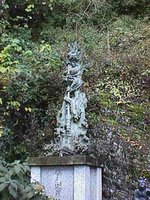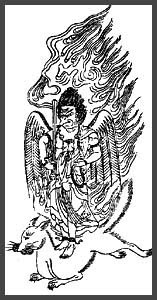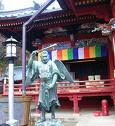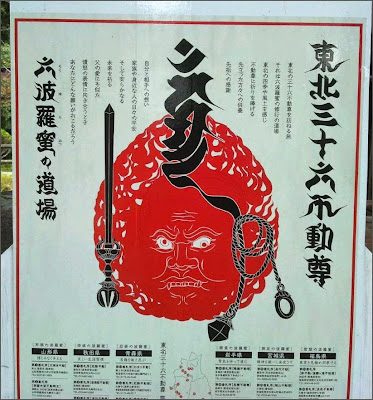[ . BACK to DARUMA MUSEUM TOP . ]
:::::::::::::::::::::::::::::::::::::::::::::::::::::::::::::::::::::::::::::::::::::::::::::::::::::::::::::::::::::::::::
Kurikara, kulika 倶利伽羅 the Sword of Fudo Myo-o
不動明王と倶利伽羅不動剣
Kurikara Fudo, Kurikara Fudoo
 source : 仏像ワールド - facebook
My MAIN Story is here:
source : 仏像ワールド - facebook
My MAIN Story is here:
The Buddhist Sword of Wisdom 知剣
chiken
. The Wisdom King Fudo Myoo-o and
the Sword Kurikara
For the other swords, see below!
:::::::::::::::::::::::::::::::::::::::::::::::::::::::::::::::::::::::::::::::::::::::::::::::::::::::::::::::::::::::::::
With the
sword of wisdom, Fudo cuts away the
sandoku 三毒 "three poisons" . three passions
三不善根 - skt: akuśala-mūla
01 貧/欲しい、惜しいの心 - desire, passion, greed
ton (lobha) represented by a rooster
02 瞋/怒りや恨み - anger, aggression, hatred
shin (dosa) represented by a snake 蛇 鶏
03 痴/正しいことが判断できない)
- confusion, bewilderment, delusion
chi (moha) represented by a pig or wild boar 豚
- quote
The three poisons (Sanskrit: triviṣa; Tibetan: dug gsum) or the three unwholesome roots (Sanskrit: akuśala-mūla; Pāli: akusala-mūla), in Buddhism, refer to the three root kleshas of ignorance, attachment, and aversion. These three poisons are considered to be the cause of suffering (Sanskrit: dukkha).

In the Buddhist teachings, the three poisons (of ignorance, attachment, and aversion) are the primary causes that keep sentient beings trapped in samsara. As shown in the wheel of life (Sanskrit: bhavacakra), the three poisons lead to the creation of karma, which leads to rebirth in the six realms of samsara.
Of these three, ignorance is the root poison.
From ignorance, attachment and aversion arise.
© More in the WIKIPEDIA !
"The Sword symbolizes more
than the simple protection of the doctrine.
It is the emblem of the victory
that knowledge gains over error."
source : quotes about Fudo
. sandoku goyoku 三毒五欲 the three poisons and five passions .
The five desires (goyoku), the five obstructions
I. They are desires for
① property, ② sexual love, ③ eating and drinking, ④ fame, and ⑤ sleep.
II. Five sense - objects:
① form, ② sound, ③ smell, ④ taste, ⑤ the tangible.
These are so called because they make desires arise in humans.
- source : nichiren-shu.org -
:::::::::::::::::::::::::::::::::::::::::::::::::::::::::::::::::::::::::::::::::::::::::::::::::::::::::::::::::::::::::::
The unmovable Fudoo (Acala Vidyaaraaja) is one of the Wisdom Kings (Myoo-oo). He is usually depicted in a very wrathful way. He is a typical Japanese deity, introduced by Kobo Daishi about 806 and soon became a special protector of the Mountain Ascetics (yamabushi). An impressive waterfall is considered the personification of Fudoo, for example the Great Waterfall at Nachi, which we met in the story about
. Kumano 熊野
Fudoo is portrayed holding a two-edged sword with a three-pronged hilt in his right hand and a coiled rope in his left hand. With this sword of wisdom, Fudoo cuts through deluded and ignorant minds and with the rope he binds those who are ruled by their violent passions and emotions.
 Click for more photos
Click for more photos
Kurikara Fudo is another personification of this deity, this time in the form of a Dragon-Sword. The
Dargon King Kurikara (Sanskrit: Kulikaa Nagaraajaa) is said to have a golden body color and is sometimes depicted with one or two horns on his head. Legend has it that Fudoo had to fight the representative of a different religion. He changed himself into a flaming sword but the opponent did the same and the fighting went on without a winner. Now Fudoo changed himself into the Dragon Kurikara, wound himself around the opposing sword and started eating it from the top. This episode gave rise to the iconographic rendering as we know it now.
The dragon used to be a vasall or symbol of the deity, but in this unique case the symbol and the deity came to be honored as the same thing. Especially during the Edo period where the sword was a symbol of the vasall's loyalty to his lord, the statues and steles of Kurikara Fudo were produced in greater numbers.
倶利加羅は、「倶梨迦羅」「古力迦羅」「倶力迦羅」などと書れ、黒色の龍を意味し、不動明王の化身とされる。この龍が燃え盛る炎に包まれながらも岩上の利剣に巻き付き剣を飲み込まんとする尊像が倶利加羅不動明王で、危険な修羅場の守り神、火消し・博奕打ちが好んで刺青に使った尊像である。
http://www.jsdi.or.jp/~kirara80/meisho/narusawa/index.html/index412.html
The kulika Dragon King symbolises the triple poison - greed, anger and folly.
:::::::::::::::::::::::::::::::::::::::::::::::::::::::::::::::::::::::::::::::::::::::::::::::::::::::::::::::::::::::::::
 source : facebook
source : facebook
:::::::::::::::::::::::::::::::::::::::::::::::::::::::::::::::::::::::::::::::::::::::::::::::::::::::::::::::::::::::::::
- quote
Kurikara 倶利迦羅
Also known as Kurika 矩里迦, a transliteration of Sanskrit
Kulika, the name of a dragon-king *ryuu 龍 mentioned in Indian legends.
In this connection he is also known as Kurikara Ryuu 倶利迦羅龍 (Dragon Kurikara), sometimes with the addition of
ou 王, to read Dragon king Kurikara. Kurikara could also be an abbreviated transliteration of
Kulika raja (King Kulika), or of Kulika-nagaraja (Dragon king Kulika).
In Esoteric Buddhism mikkyou 密教 he is regarded as a manifestation of *Fudou Myouou 不動明王 and is also known as Kurikara Fudou 倶利迦羅不動 or Kurikara Myouou 倶利迦羅明王. He assumes the form of a flame-wreathed snake or dragon coiled around an upright sword, with his open mouth about to swallow the tip of the weapon, which is called the Kurikara sword, kurikaraken 倶利迦羅剣.
According to the KURIKARA RYUUOU DARANIKYOU 倶利迦羅龍王陀羅尼経 (Kurikara Ryu-O Darani Kyo), this manifestation of Fudou had its origins in a contest between Fudou and a non-Buddhist heretic in the course of which Fudou transformed himself first into a sword and then into the dragon Kurikara and threatened to devour the sword into which the heretic had changed himself.
Alternatively the dragon and sword are sometimes said to represent the noose and sword held by Fudou and images of Kurikara may be used as a substitute for Fudou as for example on the lid of a lacquered sutra box *kyoubako 経箱 from the Heian period belonging to Taimadera 当麻寺 in Nara, where he is flanked by Fudou's two attendants *Kongara douji 矜羯羅童子 and *Seitaka douji 制た迦童子.
Early statuary representations are rare: that kept at Ryuukouin 龍光院 Mt. Kouya 高野 (Koyasan) in Wakayama prefecture, inside a small shrine *zushi 厨子 is thought to date from the Kamakura period, although temple tradition holds that the sword (42.2cm) was brought back to Japan by *Kukai 空海 (774-835).
The largest completely wooden image (183.2cm), dating from the late Heian period, is kept at Kotakeji 小武寺 in Ooita prefecture.
The Kurikara pattern, kurikara-mon 倶利迦羅紋 is also a popular motif in tattoos
irezumi 入墨.
- source : JAANUS
 source : www.diabloart.jp
source : www.diabloart.jp
:::::::::::::::::::::::::::::::::::::::::::::::::::::::::::::::::::::::::::::::::::::::::::::::::::::::::::::::::::::::::::
 source : facebook
source : facebook
at the Chiba Art Museum 千葉市美術館
:::::::::::::::::::::::::::::::::::::::::::::::::::::::::::::::::::::::::::::::::::::::::::::::::::::::
. Fudo with white eyes , Mejiro Fudo 目白不動 Tokyo
White Fudo, Shiro-Fudo 白不動 .
:::::::::::::::::::::::::::::::::::::::::::::::::::::::::::::::::::::::::::::::::::::::::::::::::::::::
Stone carving
倶利伽羅不動庚申
Erected in 1666. Compounds of the White Fudo, Edo.
 © 岩倉櫻
© 岩倉櫻
:::::::::::::::::::::::::::::::::::::::::::::::::::::::::::::::::::::::::::::::::::::::::::::::::::::
At Kawaguchi Village, Taki no Zawa
川口町滝ノ沢
This Sword Fudo watches over a watering place in a gourge of a mountain pass near Hachioji, Tokyo. There are many poisonous snakes in this area and many people died of their bites. Since the statue was erected in around 1770, Fudo protects the humans. The present statue dates from the Meiji period.
The area is also called
Fudo Valley, Fudo Yatsu 不動谷津.
There is also an old mountain cherry tree close by, said to be more than a few hundred years old, with a diameter of about three meters.
 © 川口の自然を守る会 .
© 川口の自然を守る会 .
:::::::::::::::::::::::::::::::::::::::::::::::::::::::::::::::::::::::::::::::::::::::::::::::::::::
Inunakisan, Inunaki san 犬鳴山

This statue is said to have been made by En no Gyoja himself 役行者の自作.

本地大聖不動明王
Kobo Daishi came to this region in the footsteps of En no Gyoja, carved a statue of the Great Fudo and performed sacred rites to honor this statue.
The deity would ward off evil influence and protect the pilgrim from dangers.
災厄を除き、繁栄成就、難病平癒、方災消除、家宅安穏、知恵聡明、勝負必勝、和合敬愛、安産成就、一切所求円満
犬鳴山本尊倶利伽羅大竜不動明王
犬鳴山本尊 大龍不動明王

The fire ceremony
大阪府泉 佐野市大木8
source : www.inunakisan.com
quote
Situated in Izumisano City, Mt. Inunaki is known as the location of a hot spring resort, as well as
Shippo-ryuji Temple, headquarters of the Inunaki school of Shugendo, which is one of the oldest Shugendo temples founded by En-no-gyoja about 1,300 years ago.
In the precincts of the temple 28 pilgrim spots are recognized, among which some are at main Shugendo training halls; some are near waterfalls; some at rocks; some at smaller Shugendo halls; and others at small shrines, so that many visitors can experience making a pilgrimage.
Also called “Nyonin Omine” (the alternative to Mt. Omine for women), Mt. Inunaki is famous as a Shugendo training place where women are allowed to participate in Shugendo training although they are forbidden to enter Mt. Omine, another famous Shugendo training spot.
The name
“Inunaki” (dog barking) comes from the legend that when a hunter was about to be attacked by a giant snail in the mountains in the era of Emperor Uda (887 to 897), his dog barked furiously and sacrificed himself to save his master’s life. On the way to Shippo-ryuji Temple, you can see tombs of fine and faithful dogs.
The hot spring resort located along a stream at the foot of Mt. Inunaki has an atmosphere of a quiet mountain village, with various seasonal attractions, including mountain cherry blossoms in spring, fireflies and kajika frogs in summer (“kajika” means river deer in Japanese; kajika frogs croaking sounds like deer calling), autumn leaves in autumn and fluttering snowflakes in winter.
source : www.osaka-info.jp
:::::::::::::::::::::::::::::::::::::::::::::::::::::::::::::::::::::::::::::::::::::::::::::::::::::
. Arao Fudo-In 荒尾不動院 倶利伽羅不動 Kurikara Fudo .
Kumamoto
:::::::::::::::::::::::::::::::::::::::::::::::::::::::::::::::::::::::::::::::::::::::::::::::::::::

Shikoku Henro temple
- source : photo by Oliver -
:::::::::::::::::::::::::::::::::::::::::::::::::::::::::::::::::::::::::::::::::::::::::::::::::::::

倶利伽羅不動寺西之坊鳳凰殿
Ishikawa prefecture, Kurikara Fudo-Ji Temple
128 Takenohashi, Tsubata, Kahoku District, Ishikawa
:::::::::::::::::::::::::::::::::::::::::::::::::::::::::::::::::::::::::::::::::::::::::::::::::::::
Modern Caraving of Kurikara Fudo

総柘植 倶利伽羅不動龍剣
© 昇龍堂 shouryu.com
:::::::::::::::::::::::::::::::::::::::::::::::::::::::::::::::::::::::::::::::::::::::::::::::::::::
Kurikara Pass 倶利伽羅峠
The temple Kurikara Fudo-son is located near Kurikara Pass, a place famous for the battle between the Heike Clan and Saso Yoshinaka during the 2nd year of the Eiju period (1183). The statue of Fudo Myo-O is said to be carved by Kobo Daishi.
Matsuo Basho passed here on his famous walk to the small roads in the North.
 Kurikara ga tani 倶利伽羅谷
Kurikara ga tani 倶利伽羅谷
is a valley located on the border between the provinces of Kaga and Etchu and is the valley below
Kurikara toge Pass.
This is the site where in 1184 Kiso no Yoshinaka led his forces against the great Taira army and drove them back in defeat. Yoshinaka won a night battle by tying flaming torches to the horns of cattle and stampeding them through the Taira lines in front of his advancing army.
Curiously Basho makes no mention of this, especially since the Taira army was led by Koremori.
http://www.uoregon.edu/~kohl/basho/35-kanazawa/notes.html
The battle of Kurikara, also known as the battle of
Tonamiyama (砺波山), was a crucial battle of Japan's Genpei War; in this battle the tide of the war turned in the favor of the Minamoto clan.
Background
Minamoto no Yoshinaka, commander of a contingent of warriors from Shinano province, raided Taira lands several years earlier, before his raids, and the war itself, were put on hold on account of two years of famine. As conditions improved in 1183, the Taira sought retribution against Yoshinaka. Taira no Koremori, son of Taira no Shigemori and grandson of the late Taira no Kiyomori, took charge of this operation, backed by Michimori, Tadanori, Tomonori, Tsunemasa and Kiyofusa.
Their forces severely reduced by battle and famine, the Taira sought to recruit warriors from the surrounding lands, and did so at the risk of further famine, since many of these warriors were farmers leaving their farms. Though some chronicles list their numbers as exceeding 100,000, this is a highly unlikely number, and other, more reliable sources have estimated it as being closer to 40,000.
Minamoto no Yoritomo, Yoshinaka's cousin, moved to fight him for dominance of the clan in March 1183, but was convinced to stand down and withdraw by Yoshinaka, who argued that they should be united against the Taira. To ensure his intentions, Yoshinaka also sent his son, Yoshitaka, to Kamakura as a hostage. Shortly afterwards, Yoshinaka received news of Koremori's army, and moved to engage him, along with his uncle Minamoto no Yukiie and so-called shitennō, his four most loyal retainers: Imai Kanehira, Higuchi Kanemitsu, Tate Chikatada, Nenoi Yukichika.
......................................................... snip
Meanhwhile, Yoshinaka's armies moved into position, and as the sun set, the Taira turned to find behind them a Minamoto detachment, holding far more flags than a single detachment should merit, again giving the illusion of greater numbers. Yoshinaka's central force, having gathered a
herd of oxen, now released them down the pass, directly into the Taira army, with lit torches tied to their horns. Many of the Taira warriors charged into the herd, while many others were simply knocked clean off the path, to their deaths in the rocky crags far below. Many more tried to retreat, but became lost in the various paths, meeting their deaths at the hands of Minamoto warriors lying in wait for them, or falling into various gorges and the like.
© More in the WIKIPEDIA !
Oku no Hosomichi ... 2007
Matsuo Basho and NHK
Gabi Greve
:::::::::::::::::::::::::::::::::::::::::::::::::::::::::::::::::::::::::::::::::::::::::::::::::::::
Read more about the Waterfalls connected with Fudo :
Waterfalls and Fudo Myo-o 不動滝
O-Fudo-Sama in Japan: Waterfall Ascetism (taki shugyoo)
:::::::::::::::::::::::::::::::::::::::::::::::::::::::::::::::::::::::::::::::::::::::::::::::::::::
Afuri Jinja, Oyama 大山の阿夫利神社

A statue of Kurikara-ryu-o, or
Kulika in Skt.Kurikara-ryu-o is believed to be an incarnation of Fudo-myo-o. Ryu-o is the king of dragon, and here the statue shows a dragon in a blaze is trying to swallow a sword.
http://www.asahi-net.or.jp/~QM9T-KNDU/afurim.htm.htm
. Oyama no Fudo 大山の不動様.
Kanagawa
:::::::::::::::::::::::::::::::::::::::::::::::::::::::::::::::::::::::::::::::::::::::::::::::::::::
Most statues of Fudo Myo-O have him carry a special sword

Most statues of Fudo Myo-O have him carry a normal sword
gooma ken, gooma no ken 降魔の剣 goma sword of Fudo Myo-O
subjugating the demons, demon-quelling sword
gooma riken 降魔利剣 demon-subjugating sharp sword
fudoo ken 不動剣 sword of Fudo
eken, e-ken sword of wisdom
or
riken 利剣 the double edged sword of Sapience (or Hôken)
sacred sword
sanko ken 三鈷剣, sanko no ken 三鈷の剣
sword with a three-pronged vajra
.
Sankoji 三鈷寺 Sanko-Ji - Kyoto
"temple of the three-pronged vajra.
source : www.oparaq.com
:::::::::::::::::::::::::::::::::::::::::::::::::::::::::::::::::::::::::::::::::::::::::::::::::::::::::::::::::::::::::::
 - quote
Gravures ou Horimono sur katana
- quote
Gravures ou Horimono sur katana
L'épée, ou Ken, représentait la divinité Fudo Myoo
LOOK at more photos here
- source : www.katananosekai.net
:::::::::::::::::::::::::::::::::::::::::::::::::::::::::::::::::::::::::::::::::::::::::::::::::::::::::::::::::::::::::::
- quote
Fudo's Sword
GLIMPSES INTO JAPAN'S SHAMAN PATH
AND
THE KUNDALINI DEITY FUDO MYOO
"On an afternoon in November, 1963,1 went to the Kurama temple with the intention of walking over the top of the mountain and down the other side to Kibune," chronicles British professor of Japan studies Carmen Blacker in The Catalpa Bow. "A little way down from the summit I heard from among the trees a strong hard voice reciting what sounded like mantras. I left the path and followed the voice until, in a clearing in the forest, I saw an enormous cryptomeria tree, its huge trunk girdled about with the belt of straw rope, and before it, with her back to me, a woman seated on the ground reciting. The hard base voice continued for several minutes, through a number of invocations, while the woman sat perfectly motionless with a long rosary in her hands.
Venturing to approach her, I asked if there were still a good many tengu (half-bird, half-hawk spirit) to be found on the mountain. She turned to face me, a brown face peculiarly like an old bird, with an expression fierce yet remote and a pair of extraordinarily glittering eyes, brightly sparkling like steel. 'If you do gyo [austerities] like me you can see them,' she replied abruptly. I asked again if the kami (god) in the great tree was very strong. 'Ask it. The tree is more than a thousand years,' she replied, and without another word, and without looking behind her, she plunged rapidly down the mountainside until she disappeared among the dark green trees and yellow leaves."
This wilderness mystic - a modern day miko, Shinto priestess - peacefully haunting the sacred hill valleys of Japan is not different from the revered Hindu shamans of Nepal or India. Both can ply the palpable pure energy that interconnects all form - nagare in Shinto texts and Satchidananda in Sanskrit. Both use it to heal. The Indian shaman and Japanese yamabushi mountain ascetic both perceive the many planes that invisibly interpenetrate ours. The miko plucks a koto lute; the Hindu shaman claps a bell - by sound, both alert those who live beyond. Each know how the magic of fire, mantra and meditation further stretches open the veils between these worlds for communication with the beings that reside there - kami in Japanese and devas in Sanskrit. Both understand how a mountain - or lakes, trees or rocks - can be the home of celestials. Hindus trekking along the pilgrimage pathways of Japan would naively marvel at all the "Siva lingams." Oval boulders girdled with straw bands speckle sacred hilltops, drawing the pilgrim to halt and worship. Japanese refer to the physical portal to the deity's consciousness yorishiro, "vessel" - murthi in Sanskrit.
Fudo Myoo: A Japanese Siva Reflection
Overwhelmingly a one nerve current cavernously flows beneath the Orient landmass, welling up at different points and periods as yogis - Indian, Chinese, Japanese - plumbed the uniquely Asian akasha of consciousness. Cruder overland intercourse and dispersion of ideas by trade and travel mirrored the subtler mind routes. Today religious similarities, sympathies and sensibilities wed snow-capped Fuji to icy Kailas in an unearthly way. Examples abound. Esoteric Tendai Buddhists believe Maheshwara (Siva) taught them
Yorigito, mediumship and at the secluded mountainside temple of Ryosanji, in Okayama, an ichiko, priest, wears large white swastikas, the ancient Hindu symbol, embroidered on front and back of his indigo gown.
The Shiva-like Japanese Deity Fudo Myoo re-echoes this pan-Asian interlacing. Like Shiva, Fudo Myoo specially befriends the recluse, mystic and mountain hermit, granting boons and powers. Fudo Myoo, explains Dr. Carmen Blacker, is the "central and paramount figure in the group of divinites known as the Godai Myoo or Five Great Bright Kings, who in esoteric Buddhism stand as emanations, or modes of activity, of the Buddha. His long hair hangs in a coil over his left shoulder." Like Siva Nataraja, He is always ringed with fire. The ichiko or Japanese shaman sees Fudomyoo as his own most interior Self and meditates on this essential oneness just as the Saivite tantric seeks to merge with Shiva-ness within. "Fudo is frequently represented by his attribute, an erect sword," continues Dr. Blacker, "twined about by the dragon Kurikara," not unlike Shiva entwined by a serpent and often represented by his trident alone. "The halo of flames which surrounds Fudo is the same fire which the ascetic must kindle in himself. Here again is surely a reminder of the kundalini snake which as it rises up the spine of the yogi confers upon him heat and transformed sexual energy. As it writhes spirally upwards round Fudo's erect sword, we see the shakti or feminine energizing force in its traditional serpent aspect. Once again we meet with this mysterious coincidence of images, so far unexplained, between India and Japan."
Article copyright Himalayan Academy.
- source : www.hinduismtoday.com
. yorigitoo 憑祈祷 / 憑り祈祷 exorcistic 祈祷 kito rituals .
:::::::::::::::::::::::::::::::::::::::::::::::::::::::::::::::::::::::::::::::::::::::::::::::::::::::::::::::::::::::::::
Schwert-Fudoo (Kurikara Fudoo)
Zweischneidiges Schwert, von einem Drachen umwickelt, der die Schwertspitze im Maul hält. Der Drachenkönig Kurika (Sanksrit: Kulikah) hat eine goldene Körperfarbe. Manchmal mit einem Horn auf dem Kopf dargestellt. Von einem flammenden Nimbus umgeben.
Nach einer Überlieferung kam es einmal zu einem Wettkampf zwischen Fudoo Myoooo und dem Vertreter einer anderen Religion. Dabei verwandelte sich Fudoo in ein flammendes Schwert, aber der Gegner tat dies ebenfalls und sie fochten ohne Ergebnis. Nun verwandelte Fudoo sich in den Drachen Kurika, umwand das Schwert des Feindes und begann, es von der Spitze her zu verschlingen. Nach dieser Geschichte entstand das Kurikara-Schwert.
Drache zunächst als Bote bzw. Symbol des Fudô und später als die Gottheit selbst verehrt. Einziges Beispiel, bei dem Symbol und Gottheit getrennt und doch als Gleichwertig verehrt werden. Für die Samurai der Edo-Zeit war das Schwert ein ganz besonderer Gegenstand der Vasallentreue; in dieser Zeit breitete sich der Kurikara Fudoo besonders aus.
Aus Holz, Bronze, Eisen oder Stein. Oft entweder in der Myôô-Halle oder davor aufgestellt.
© Gabi Greve
Buddhastatuen (Buddha statues) Who is Who
Ein Wegweiser zur Ikonografie von japanischen Buddhastatuen
:::::::::::::::::::::::::::::::::::::::::::::::::::::::::::::::::::::::::::::::::::::::::::::::::::::::::::::::::::::::::::
Statue with Fudo holding his Kurikara sword
神代楠一木造 made from one piece of very old kusunoki 楠 camphor
 - source : www.m-butsuzou.com - Mitooka -
. 水戸岡伯翠 Mitooka Hakusui .
- source : www.m-butsuzou.com - Mitooka -
. 水戸岡伯翠 Mitooka Hakusui .
Mitooka 水戸岡仏像彫刻研究所
Buddha Statues Store and Research
:::::::::::::::::::::::::::::::::::::::::::::::::::::::::::::::::::::::::::::::::::::::::::::::::::::::
. Nanzoo-In 南蔵院 Nanzo-In, Nanzoin .
Fukuoka, Kyushu
Statue of Fudo Myo-O with a Dragon face !

:::::::::::::::::::::::::::::::::::::::::::::::::::::::::::::::::::::::::::::::::::::::::::::::::::::::::::::::::::::::::::
 - reference source : facebook -
. 犬鳴山 Inukaisan 七宝瀧寺 Shipporyu-Ji .
- reference source : facebook -
. 犬鳴山 Inukaisan 七宝瀧寺 Shipporyu-Ji .
:::::::::::::::::::::::::::::::::::::::::::::::::::::::::::::::::::::::::::::::::::::::::::::::::::::::::::::::::::::::::::
The Gods of War:
Sacred Imagery and the Decoration of Arms and Armor
By Donald J. LaRocca
the triple-pronged
vajra as the hild of the sacred sword
look at a photo here :
- source : books.google.co.jp
:::::::::::::::::::::::::::::::::::::::::::::::::::::::::::::::::::::::::::::::::::::::::::::::::::::::::::::::::::::::::::
. Swords with Dragon decorations .
[ . BACK to WORLDKIGO . TOP . ]
[ . BACK to DARUMA MUSEUM TOP . ]
- - -
- #kurikara -
:::::::::::::::::::::::::::::::::::::::::::::::::::::::::::::::::::::::::::::::::::::::::::::::::::::::::::::::::::::::::::




























































